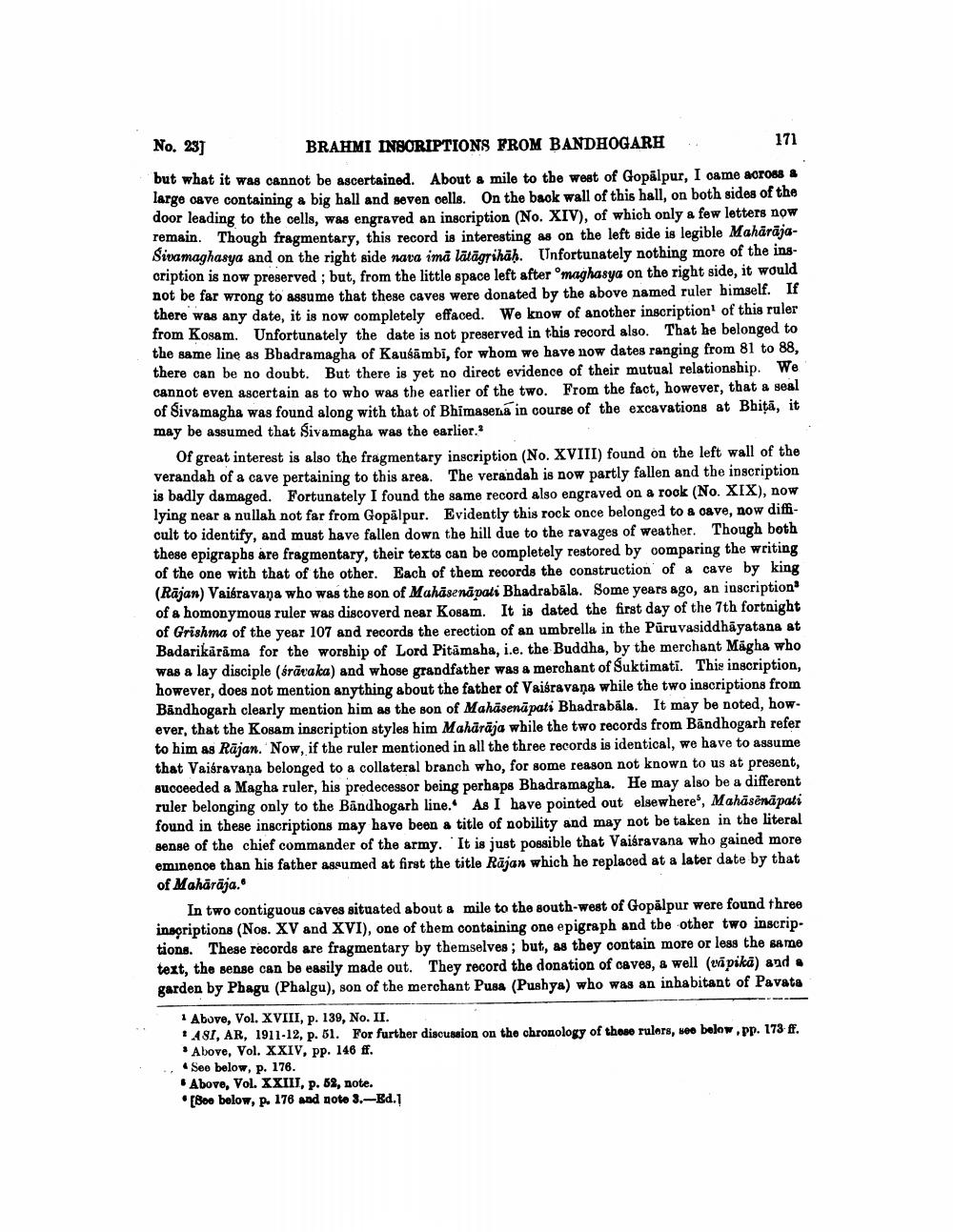________________
No. 23)
BRAHMI INSCRIPTIONS FROM BANDHOGARH.
171
but what it was cannot be ascertained. About & mile to the west of Gopālpur, I came across & large gave containing a big hall and seven cells. On the back wall of this hall, on both sides of the door leading to the cells, was engraved an inscription (No. XIV), of which only a few letters now remain. Though fragmentary, this record is interesting as on the left side is legible MahārājaSivamaghasya and on the right side nava ima lātāgrihāh. Unfortunately nothing more of the inscription is now preserved ; but, from the little space left after maghasya on the right side, it would not be far wrong to assume that these caves were donated by the above named ruler bimself. If there was any date, it is now completely effaced. We know of another inscription of this ruler from Kosam. Unfortunately the date is not preserved in this record also. That he belonged to the same line as Bhadramagha of Kausāmbi, for whom we have now dates ranging from 81 to 88, there can be no doubt. But there is yet no direct evidence of their mutual relationship. We cannot even ascertain as to who was the earlier of the two. From the fact, however, that a seal of Sivamagha was found along with that of Bhimasena in course of the excavations at Bhitā, it may be assumed that Sivamagha was the earlier.
Of great interest is also the fragmentary inscription (No. XVIII) found on the left wall of the verandah of a cave pertaining to this area. The verandah is now partly fallen and the inscription is badly damaged. Fortunately I found the same record also engraved on a rook (No. XIX), now lying near & nullah not far from Gopālpur. Evidently this rock once belonged to & cave, now difficult to identify, and must have fallen down the hill due to the ravages of weather. Though both these epigraphs are fragmentary, their texts can be completely restored by comparing the writing of the one with that of the other. Each of them records the construction of a cave by king (Rājan) Vaisravana who was the son of Mahāsenapati Bhadrabāla. Some years ago, an inscription of a homonymous ruler was discoverd near Kosam. It is dated the first day of the 7th fortnight of Grishma of the year 107 and records the erection of an umbrella in the Puruvasiddhāyatana at Badarikarama for the worship of Lord Pitāmaha, i.e. the Buddha, by the merchant Magha who was a lay disciple (śrāvaka) and whose grandfather was a merchant of Suktimati. This inscription, however, does not mention anything about the father of Vaisravana while the two inscriptions from Bandhogarh clearly mention him as the son of Mahäsenäpati Bhadrabāla. It may be noted, how. ever, that the Kosam inscription styles him Mahārāja while the two records from Bandhogarh refer to him as Rājan. Now, if the ruler mentioned in all the three records is identical, we have to assume that Vaisravana belonged to a collateral branch who, for some reason not known to us at present, succeeded a Magha ruler, his predecessor being perhaps Bhadramagha. He may also be a different ruler belonging only to the Bandhogarh line. As I have pointed out elsewhere", Mahasenapati found in these inscriptions may have been a title of nobility and may not be taken in the literal sense of the chief commander of the army. "It is just possible that Vaisravana who gained more eminence than his father assumed at first the title Rājan which he replaced at a later date by that of Maharaja.
In two contiguous caves situated about a mile to the south-west of Gopalpur were found three inscriptions (Nos. XV and XVI), one of them containing one epigraph and the other two inscriptions. These records are fragmentary by themselves; but, as they contain more or less the same text, the sense can be easily made out. They record the donation of caves, & well (evāpika) and garden by Phagu (Phalgu), son of the merchant Pusa (Pushya) who was an inhabitant of Pavata
1 Above, Vol. XVIII, p. 139, No. II. + 481, AR, 1911-12, p. 51. For further discussion on the chronology of those rulers, see below. pp. 173. ff. Above, Vol. XXIV, pp. 146 ff.
See below, p. 176. . Above, Vol. XXIII, p. 62, note. [Bee below, p. 176 and goto 3.-Ed.I




